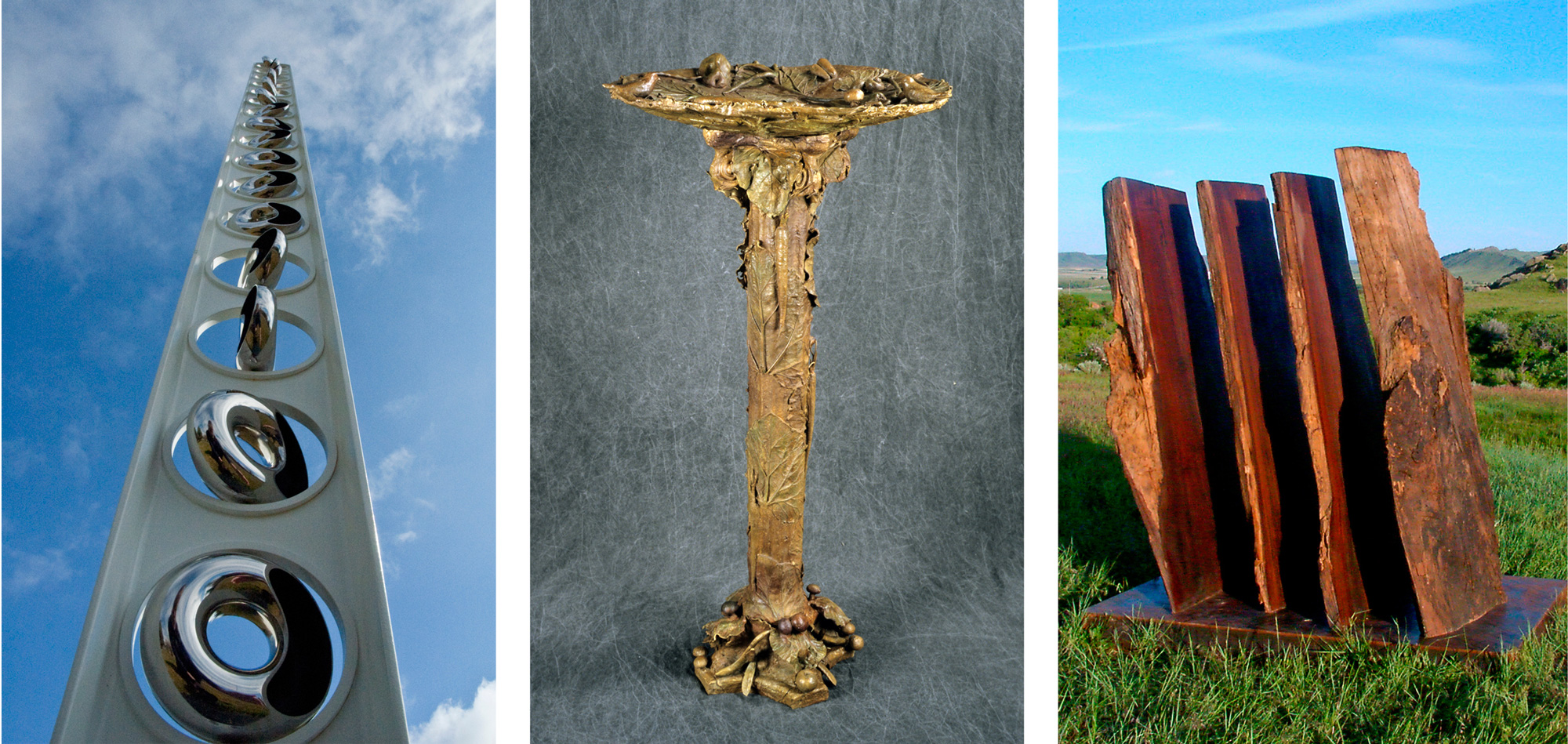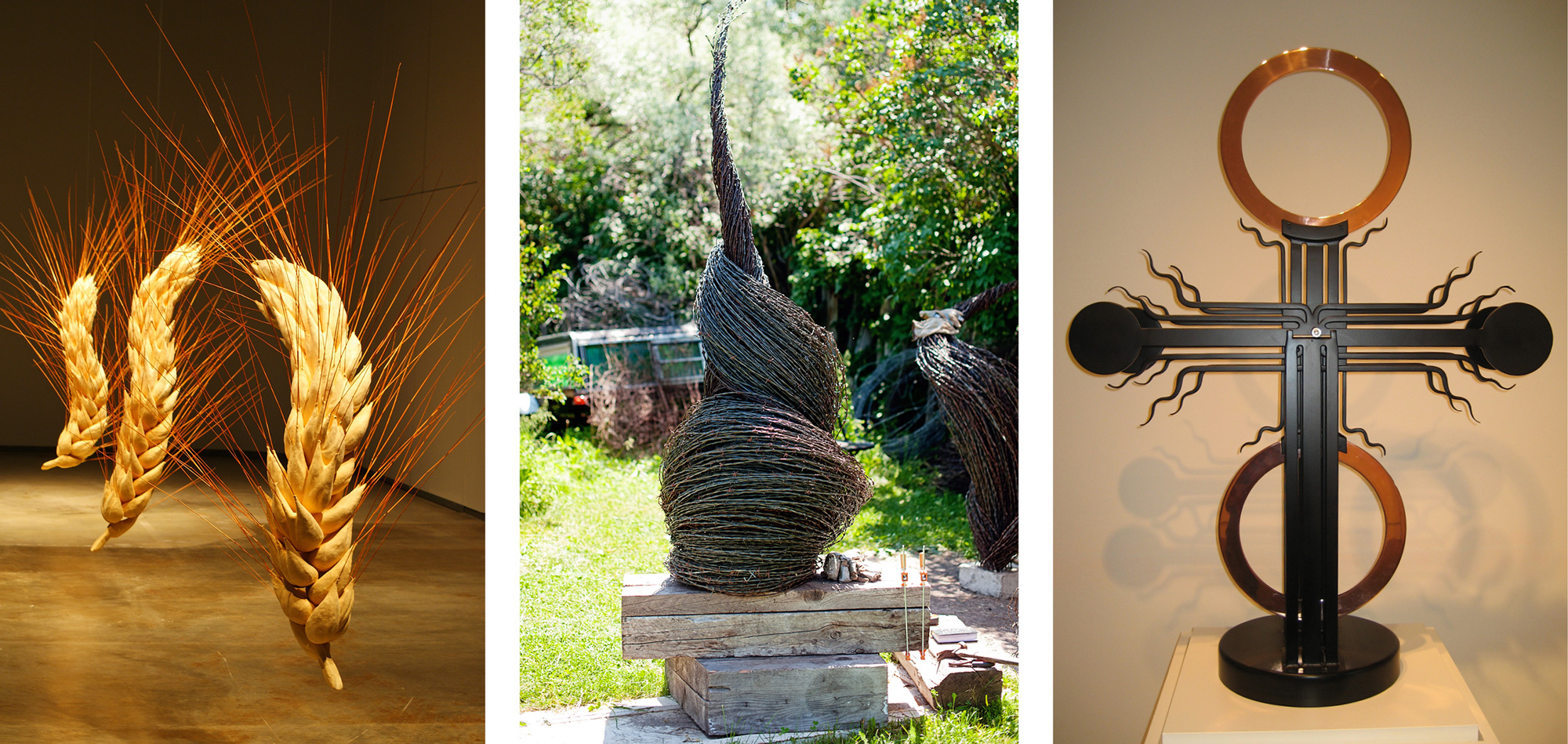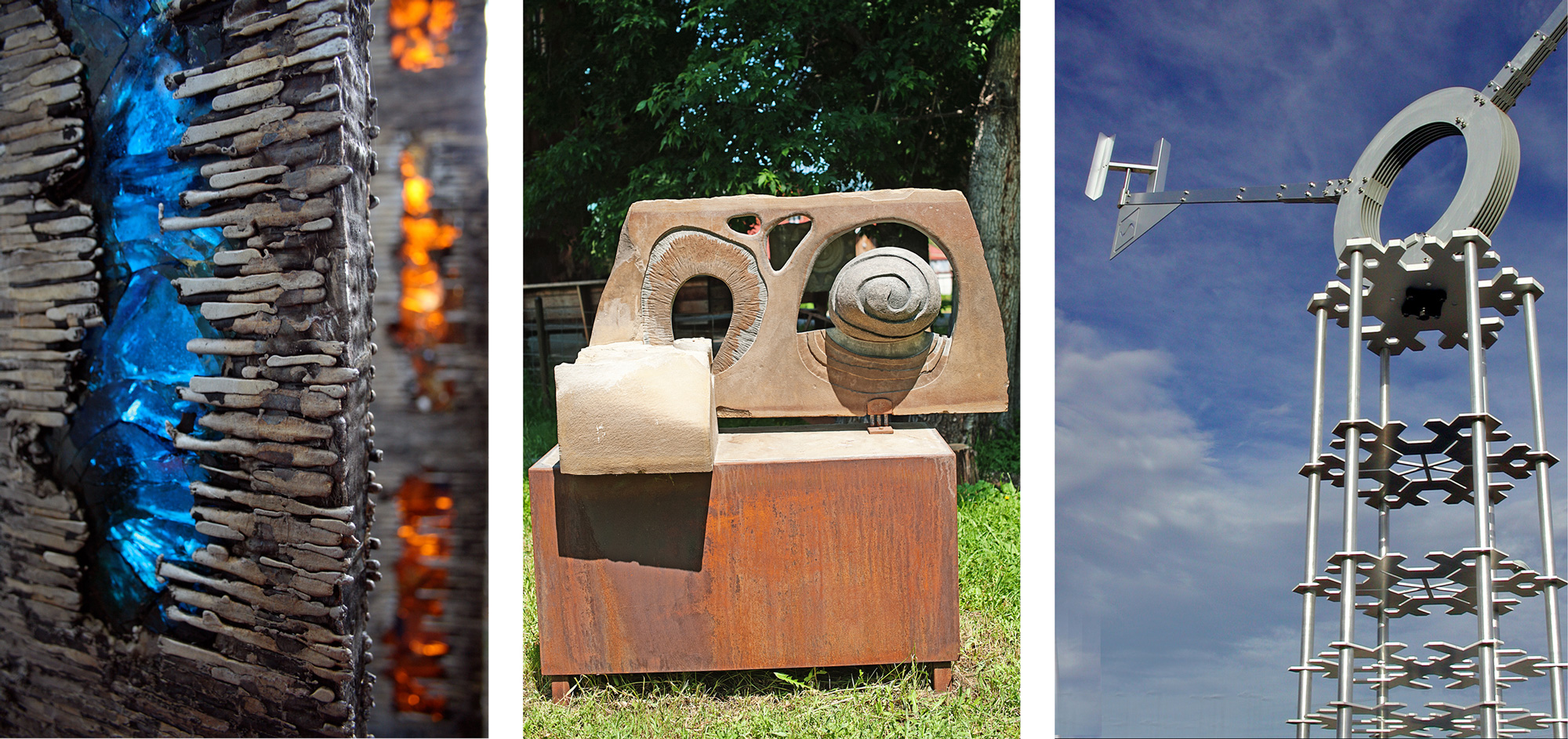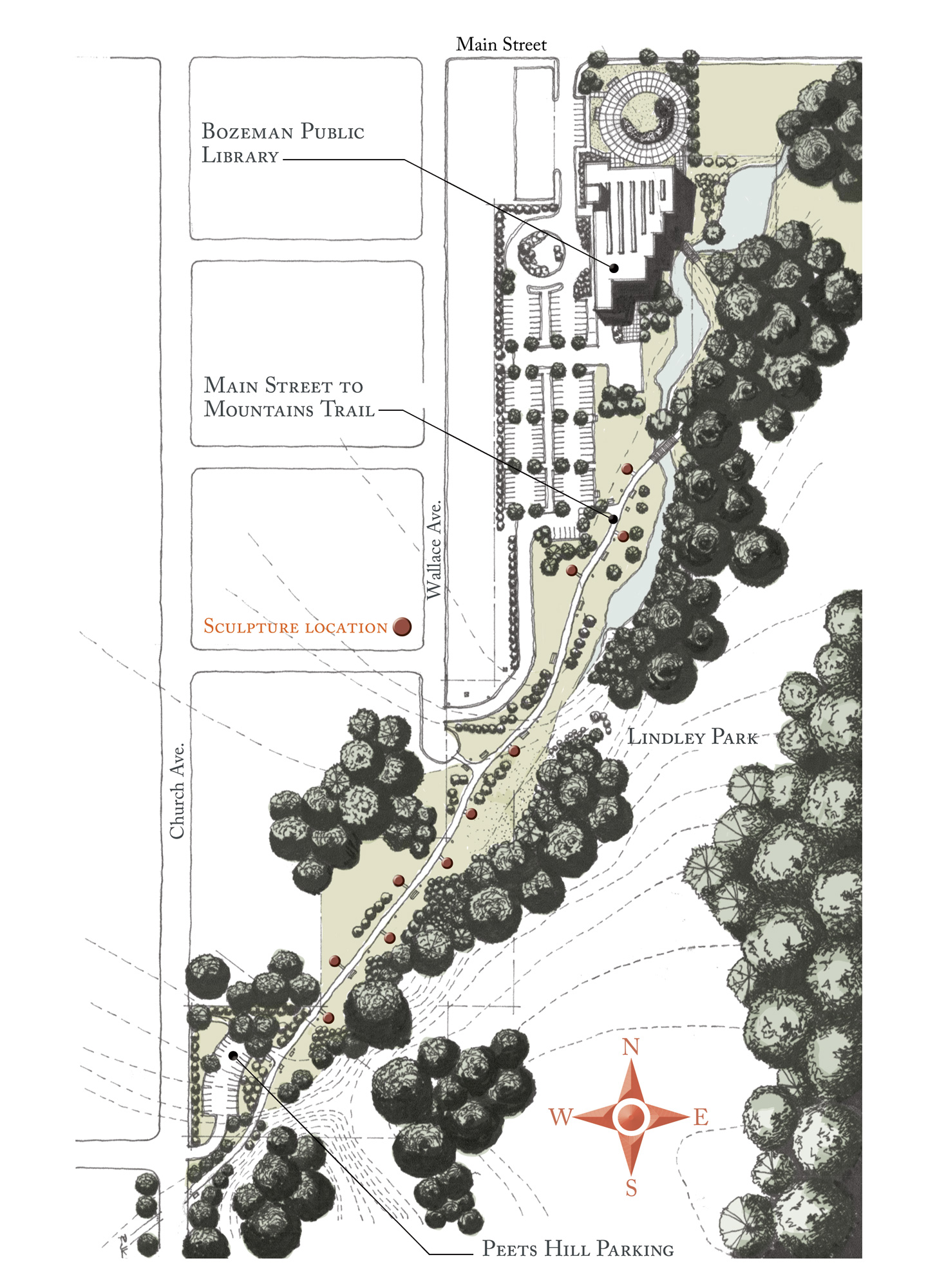
24 Jul Bozeman Sculpture Park: Creating a Conversation
AS ARTIST PATRICK ZENTZ, OF LAUREL, MONTANA, walked through the grounds of Bozeman’s future sculpture park, the only one of its kind in the state, he took his time choosing a site for his work. “You have to figure out where your work will look good and integrate with the other artists’ work, so it has some cohesion to it,” Zentz explains. Zentz is no stranger to this process. A recipient of the 1990 National Endowment of the Arts (NEA) grant, he has been commissioned over the years to complete 20 public works spanning the country from Washington State to Maryland. His sculptures are closely tied to the landscape in which they are displayed, and he carefully integrates each viewshed into his pieces even before they’re built. He even translates the landscape into numbers, like his own secret artistic code.
“For this project, it’s spectacular to have the ridge of the Bridgers in the distance and the library immediately visible,” Zentz says, describing the spot he chose for his future work of art. “I’m interested in treating that three-dimensionally, using numbers to define the space we walk in. This sculpture will be a physical object derived from numbers from that site.”
Along with eight other Montana artists, Zentz’ sculpture will be part of The Bozeman Sculpture Park’s inaugural exhibit. Located on the grounds of the Bozeman Public Library, a grand opening celebration will be held on August 27, 2011. This new outdoor venue brings a year-round collaborative art show and lecture series to the Bozeman community. Lining the paved path from the back of the Bozeman Public Library toward Peet’s Hill, with Lindley Park on the one side and the library parking lot on the other, the sculptures will be scattered about in different spots chosen by each artist.
Nine sculptures will be on display the first year, and on the third Wednesday of each month, from September 2011 through June 2012, lectures will be held in the Bozeman Public Library community room, with each artist discussing their work. The artwork will rotate each year, featuring different Montana artists. And each year, the park’s board of directors hopes to add more sculptures, with up to 24 on exhibit in the future.
Bozeman Sculpture Park curator and local artist Terry Karson, formerly a curator at the Yellowstone Art Museum in Billings, was tasked with selecting a diverse array of artists.
“There are so many good artists in this state, and I ended up inviting artists I could trust to be responsive and responsible to me as a curator,” Karson says. “I also chose a group that would create a great conversation.”
Being the Bozeman Sculpture Park’s first year, Karson intentionally invited artists he knows. Familiar with their work and style, he feels confident that this is a good way to start. In the future, he says, they may include a call for artists, but for now the invitational format was more practical.
This year’s artists range in age from 33 to 66 and all happen to live between Bozeman and Billings. The sculptures, many of which were still in process at press time, will range in size from 4 feet to 13 feet tall, from dainty to monumental. The works also range in materials from wood and steel to resin and barbed wire
Although the artists will be paid a stipend for their work, it’s not a large one, and in most cases it will barely cover their costs. Still, each one jumped on board when approached. “That’s what artists do; we make art whether we can sell it or not,” Karson says. “It’s exposure, and it’s supporting the concept of a sculpture park in Montana, which the artists are excited about because it’s the first.” He also explains that the lack of a contemporary art museum in Bozeman leaves some talented Montana artists without representation. He hopes the sculpture park will help fill this gap, at least for the time being.
Karson feels confident that the variety of artistic styles will work well together in this setting. “With open space on one side and warehouses and old grain buildings on the other, it creates an urban-wild interface,” he says.
And because Karson is familiar with the artists, he was able to give them a certain amount of freedom, allowing him more time to focus on other issues that arise in the development stages of a new project, including infrastructure. The Bozeman city commission has to approve chosen spots and make sure there are no gas or water lines underneath them. He will also oversee the pouring of concrete pedestals that range in size depending on the scale of the sculptures.
That work seems easy compared to the infrastructure that had to be put in place to get this project underway. The Bozeman Sculpture Park is coming to fruition after more than three years of planning, wading through the paperwork necessary to become a 501(c)(3) non-profit, building a board and developing the funding to pull it off.
Bozeman-based artist Zak Zakovi originally conceived the idea. After he proposed it to the Bozeman Public Library Foundation in January of 2009, they welcomed it during a time when they were planning land use within the 14-acre lot on which the library sits.
“We like the community to feel some ownership in the land, especially after we’ve done so much to clean it up,” says Paula Beswick, Director of the Bozeman Library Foundation. “We thought about what we could give back to the community with this land that still allows it to be open space and available for other uses.”
After a year’s worth of meetings among and with the library’s grounds Master Planning Committee and the community, the foundation took in every comment and suggestion and started figuring out what made the most sense. In the end, Zakovi’s proposed sculpture park was a perfect fit for an imperfectly shaped piece of land.
“It’s a funky 14 acres, the way the plot is delineated,” Beswick explains. “Putting something like a sculpture park could really add value and provide cultural art and, for the community, a destination spot.”
Beswick explains that libraries today are faced with the dilemma of remaining relevant, and to do this many libraries are striving to provide unique content and unique experiences to keep visitors coming through the doors.
[A site plan created by architect and local artist R. Joseph Keith shows the layout of land where each sculpture will be installed.]
A site plan created by architect and local artist R. Joseph Keith shows the layout of land where each sculpture will be installed.
“We envision people, as they’re taking their normal route to the library, having something new to see with yearly exhibits. And visitors too. They can come to the library, jump on the Internet, attend free programs, have a guided tour of the sculpture park and maybe one of the inside art.”
Beswick believes this adds value to the Bozeman community and the experience of visitors to Bozeman. It also complements the many other programs that the library hosts — music, yoga, classes for kids — that helps connect the library and the community creatively.
Karson started out as an advisor to the Bozeman Sculpture Park board and was a natural choice for curator once the project came together. Zakovi served as the president of the board, handling much of the legwork and logistics to get it off the ground. Once the ball was rolling, Zakovi resigned so that he could participate as an artist in the opening show.
Karson walked artists through the future park, allowing them to use their own personal techniques for choosing a spot, just as Zentz used numbers to find his.
“I spent a lot of hours with various artists in the park individually,” Karson says. “And each artist chose a completely unique spot.”
Some will be located in quiet locations, such as Bozeman-based artist Clarice Dreyer’s piece, which will be slightly tucked away by the streambed with a bench nearby for viewing. Others will be more exposed, such as Zakovi’s piece that will stand near the Wallace Street back entrance to the library parking lot. Each artist’s chosen spot will hopefully create the conversation that Karson intended through the collaboration of these nine Montana artists and the community.
- Left: “Wheat” by Tracy Linder, Molt, Montana | Leather and Polyester Resin | 78” x 60” each | Photo by Tracy Linder • Center: “Six Seven Eight” by Jennifer Pulchinski, Bozeman, Montana | Barb Wire | 102” x 30” x 30” | Photo by Doug Loneman • Right: “Copper Comet” by Charles Ringer, Joliet, Montana | Kinetic Steel and Copper | 54” x 43” x 16” | Photo Charles Ringer
- Left: “Breath” (detail) by Brian Scott, Billings, Montana | Cast Aluminum, Glass, Steel |124” x 7” each | Photo by Brian Scott • Center: “3 Stone Tree” by Zak Zakovi, Bozeman, Montana | Stone and Steel | 60” x 60” x 36” | Photo by Doug Loneman • Right: “H20” (base detail) by Patrick Zentz, Laurel, Montana | Aluminum, Concrete, Steel | 176” x 183” | Photo Patrick Zentz
- Sculpture Park Curator and local artist, Terry Karson walks the paved path behind the Bozeman Public Library toward Peet’s Hill, with Lindley Park on the one side and the library parking lot on the other, where the sculptures will be juxtaposed to enhance the landscape. Photo by Doug Loneman
- A site plan created by architect and local artist R. Joseph Keith shows the layout of land where each sculpture will be installed.








No Comments